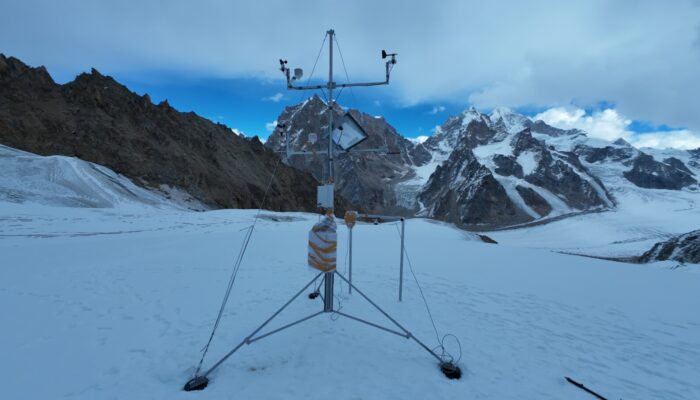Would you like to follow the endeavours of a small team working in the ice-marginal terrain in South-West Greenland? They set out to investigate proglacial lakes using sediment coring, water sampling and gas collections (figure 1), aiming to better understand methane dynamics, proglacial terrain development and the environmental drivers behind methane production in glacially influenced lake system ...[Read More]
If you didn't find what you was looking for try searching again.
Cryospheric Sciences
Tracking the Footprints of a Vanishing Glaciers in the Greater Caucasus
In this week’s blog, Levan Tielidze tells us about his recent glacier study from the Greater Caucasus. By combining geomorphology, remote sensing, and historical cartography, the team reconstructed nearly 200 years of glacier and climate change across one of the world’s most dynamic cryospheric frontiers. Glaciers’ transformation provides a high-resolution archive of post-Little Ice Age climate dy ...[Read More]
Cryospheric Sciences
A Scientific Quest from Australia to Antarctica
In this week’s blog, Levan Tielidze tells us about his participation in a scientific expedition to Dronning Maud Land, Antarctica, during the 2024–2025 field season. The journey, commencing in Australia and passing through South Africa, led him to the “surreal” and “awe-inspiring” Antarctic landscape. The team, a collaborative effort from Monash University, and the Un ...[Read More]
Cryospheric Sciences
EGU 25 – we’ve got you covered
Are you attending this year’s EGU General Assembly virtual or in person? No matter the way you attend or if it’s your first time or you are coming to Vienna for the GA for years, today we share with you some cryosphere programme highlights and general tips on how to make the most out of your conference experience. Every year, we summarise the main cryosphere events for you, those for inspira ...[Read More]
Cryospheric Sciences
Field notes from the Chhota Shigri Glacier: A journey of science and survival in the Himalaya
I’m Himanshu Kaushik, a PhD student working under the guidance of Dr. Mohd Farooq Azam at the Indian Institute of Technology Indore (India). Seven years ago, I took my first steps onto the Chhota Shigri Glacier (CSG) in the Indian (Western) Himalaya, and it felt like stepping into another world. Surrounded by the towering peaks, it seemed otherworldly and humbling. After that first expeditio ...[Read More]
Cryospheric Sciences
Uncovering Antarctica’s hidden subglacial lake network with satellite altimetry
Measuring ice surface elevation changes with satellite laser altimeters flying hundreds of kilometres above Earth tells us where the Antarctic and Greenland ice sheets are thinning or thickening and how much they contribute to sea level rise. Beyond that though, it can also reveal hidden activity of subglacial lakes filling and draining beneath the ice and meltwater rivers flowing ou ...[Read More]
Cryospheric Sciences
Crossing borders – Glacier fieldwork at Sulitjelma/Salajekna
The time I first set foot at the university, I didn’t expect that two weeks later I would be looking at a backpack more than half my size, turning my back to the shelter of our rental car and walking almost 100 km in the Norwegian Arctic. Howling winds, heavy backpacks, daunting bridges, and endless beauty – that’s how I would describe my first experience with glacier fieldwork. I, Silje Waa ...[Read More]
Cryospheric Sciences
A First-Timer’s Journey to the Heart of the Himalayas
I am Krishnanand J, a graduate student in glaciology from IISER Pune, India. This is a story about my very first field trip to the Himalaya. Coming from a small village in Kerala, which is the southernmost state of India, going to the Himalaya is considered a big thing. It is like a camel visiting Antarctica. So below, I will take you along on an immersive journey, as I tell you about my first fie ...[Read More]
Cryospheric Sciences
World Mental Health Day 2024 with a focus on workplace
Friday the 10 October, was World Mental Health Day, a day that was founded by the World Federation for Mental Health (WFMH) in 1992. This year’s official theme focuses specifically on mental health in the work environment. So let’s take a look at what this means for the field of academia and the cryosphere specifically. With this post, we aim to not only raise awareness of the mental health crisis ...[Read More]
Cryospheric Sciences
Cryoscientist life stories – an interview with our incoming deputy division president, Daniel Farinotti
We would like to introduce Daniel Farinotti to you, our Cryosphere Division incoming deputy president, who will take over as division president from 2025-2027. For that, our Cryosphere Division outreach officer, Larissa van der Laan, interviewed Daniel at the EGU General Assembly in April 2024, to ask him a few questions about himself and his view of this exciting role within the EGU. Larissa: Hi ...[Read More]


![Aerial image showing the climate change impact on small glaciers in the central Greater Caucasus, Georgia. Slopes are extensive deposits of moraines and loose rock debris, left behind by retreating glaciers. A small glacial lake (near the center-bottom of the image) fed by meltwater from the surrounding ice and snow was developed after glacier retreat [Credit: Levan Tielidze].](https://blogs.egu.eu/divisions/cr/files/2025/06/Fig0-700x400.jpg)







